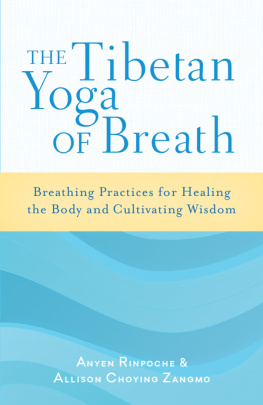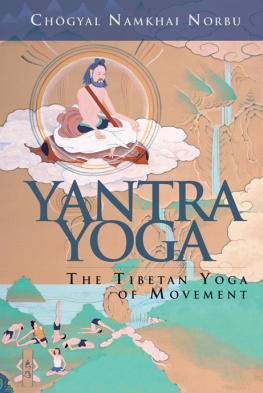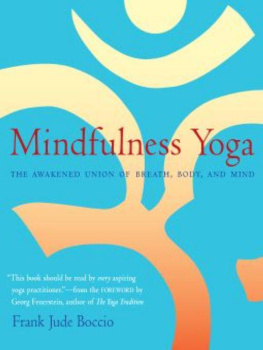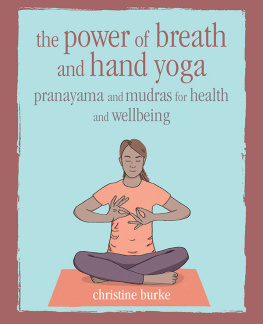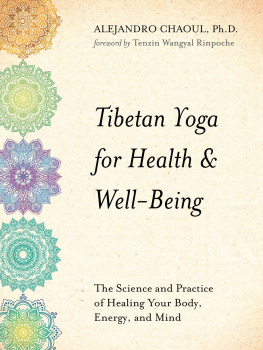Meticulously guides readers on how to awaken and perfect the power of innate energy to heal and enlighten.
Tulku Thondup, author of Boundless Healing
These clear and practice-based teachings on purifying the wind energies are much-needed medicine for our times. Rooted in the ancient wisdom of dharma and an understanding of modern science, the yogas of the body, wind energy, and mind are presented in a fresh, lively prose that is a delight to read.
Tsoknyi Rinpoche
ABOUT THE BOOK
Modern science and classic spiritual traditions agree: regulating the breath leads to radiance and wellness of body, mind, and spirit. With the simple teachings and cutting-edge research offered in The Tibetan Yoga of Breath, you can start thriving just by integrating breathwork into your daily practice.
Basic Yantra Yoga techniquesalso called wind energy trainingare the key to achieving this kind of vitality, down to the cellular level. Anyen Rinpoche and Allison Choying Zangmo skillfully examine the teachings of Yantra Yoga and Buddhism through the lens of Western medical science. Their wise and accessible instruction reveals practices that are nourishing and transformative, delivering dramatic resultsno experience with yoga or Buddhist meditation necessary.
ANYEN RINPOCHE is a tulku from Tibet of the Nyingma (Longchen Nyingthig) Tradition. He primarily lives in Denver, Colorado, where he founded Orgyen Khamdroling Dharma Center with a shedra (college) for Westerners. He is the author of The Union of Dzogchen and Bodhichitta, Dying with Confidence, Journey to Certainty, and Momentary Buddhahood.
ALLISON CHOYING ZANGMO is Anyen Rinpoches personal translator and a longtime student of both Rinpoche and his root Lama, Kyabje Tsara Dharmakirti. She has either translated or collaborated with Rinpoche on all of his books. She lives in Denver, Colorado.
Sign up to learn more about our books and receive special offers from Shambhala Publications.

Or visit us online to sign up at shambhala.com/eshambhala.
The Tibetan Yoga of Breath
Breathing Exercises for Healing the Body and Cultivating Wisdom
Anyen Rinpoche & Allison Choying Zangmo

SHAMBHALA
Boston & London
2013
Shambhala Publications, Inc.
Horticultural Hall
300 Massachusetts Avenue
Boston, Massachusetts 02115
www.shambhala.com
2013 by Anyen Rinpoche and Allison Choying Zangmo
All rights reserved. No part of this book may be reproduced in any form or by any means, electronic or mechanical, including photocopying, recording, or by any information storage and retrieval system, without permission in writing from the publisher.
Library of Congress Cataloging-in-Publication Data
Anyen, Rinpoche.
The Tibetan yoga of breath: breathing exercises for healing the body and cultivating wisdom/Anyen Rinpoche and Allison Choying Zangmo.
pages cm
Includes bibliographical references and index.
eISBN 978-0-8348-2917-6
ISBN 978-1-61180-088-3 (pbk.: alk. paper)
1. Yoga. 2. Breathing exercises. I. Title.
RA781.67.A68 2013
613.7046dc23
2013011863
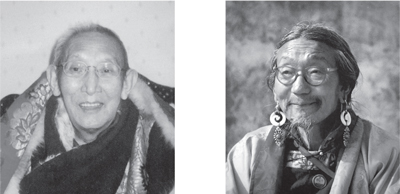
We offer this book and all of our effort toward its creation to the supreme Yantra Yoga masters Khenchen Tsara Dharmakirti Rinpoche and Nyakrung Tsunpo Dorlo Rinpoche.
In all my future lifetimes,
May I never be separate from the perfectly pure Lama.
Having received the jewel of the glorious Dharma,
May I perfect the good qualities of the stages and paths
And swiftly attain the state of the Glorious Lama.
Contents
We would like to extend our gratitude and appreciation to Sarah Teague Johnson for her many hours of research, editing, and consultation in the preparation of this manuscript. Thank you also to Eileen Cahoon and Myra Young for advice and time spent editing the draft manuscript.
Since meeting Anyen Rinpoche more than thirteen years ago, I have heard many tales of the great masters of Tibet. Some of the most incredible and wondrous stories are those of one of his root masters, Tsunpo Dorlo Rinpoche, a great master of Yantra Yoga and the profound meditation tradition of Dzogpachenpo: the Great Perfection. The Great Perfection is the most profound style of meditation in the tradition of Tibetan Buddhism presented in this book, that of the Nyingmapa Secret Mantrayana. The Great Perfection is complemented by the breathing and asana poses that make up an ancient style of Tantric Yoga, called Yantra Yoga. Yantra Yoga is the formal name of a contemplative tradition of working with the bodys energetic channels, wind energies (which includes the breath), and vital essences.
Not everyones body is suited to practice the strenuous asana poses presented in the tradition of Yantra Yoga. It is light-years away from the relatively gentle style of yoga many of us practice in modern America. However, Anyen Rinpoche often told me that the root of Yantra Yoga is working with the breath, and that all great yogis learn the basic breathing techniques of Yantra Yoga as part of their spiritual mastery.
Practicing Yantra Yoga has enabled the great yogis of India and Tibet to achieve miraculous feats, such as personal healing even from incurable illnesses, the ability to withstand physical hardships such as a lack of food or warmth even for long periods of time, and, of course, the complete realization of wisdom, where one is liberated from all concepts of the ego and of dualistic perception. Dorlo Rinpoche was an unusual kind of Yantra Yoga master for the modern age. He exhibited behavior that reaches the level of a fairy tale, such as having such pure and controlled use of the breath that he only needed to breathe a few times an hour. Anyen Rinpoches and my own root teacher, Tsara Dharmakirti Rinpoche, also relied upon the teachings on Yantra Yoga and the Great Perfection to completely heal himself from cancer in his younger years.
Anyen Rinpoche studied Yantra Yoga with Dorlo Rinpoche in a traditional retreat setting, during the coldest time of year in an earthen dwelling high in Kham, Tibet. The practitioners of that retreat studied tummo, the generation of inner heat, among other practices. Practicing in a harsh, frigid environment is essential to the practice, as it motivates the retreatants to practice extremely diligently until the body naturally generates heat despite the cold environment. At the culmination of the retreat, Anyen Rinpoche was tested in the traditional manner by allowing the shoulders of his unclothed body to be draped with a damp towel, which then had to be dried by the bodys own inner heat.
The teachings on Yantra Yoga explain in detail the manner in which the purification of the breath acts as the cause for healing body and mind and, ultimately, for spiritual realization. The breathing practices of the Yantra Yoga tradition are referred to as wind energy training throughout this book. The basis for these practices is introduced in part 1, and the practice of wind energy training is introduced in greater detail in part 2.
I grew up in the suburbs of Denver, Colorado, as an ordinary, middle-class girl. Most of my childhood was spent feeling caught between two worlds. My yearning for a contemplative lifestyle existed in contrast to a society that believes in material wealth, status, and power as the ultimate measure of success. As a result, I experienced isolation, anxiety, and sleeplessness. My traditional American childhood gave me few tools to help me deal with these feelings. I was introduced to meditation and contemplative practice at the age of sixteen, after which I began practicing meditation seriously. I finally felt I had connected with the thing that was missing in my life. In my early twenties, I traveled to Tibet and then Nepal, where I met Anyen Rinpoche and became deeply involved in the contemplative and devotional practices of Tibetan Buddhism.
Next page
